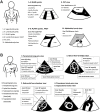SEARCH 8Es: A novel point of care ultrasound protocol for patients with chest pain, dyspnea or symptomatic hypotension in the emergency department
- PMID: 28355246
- PMCID: PMC5371336
- DOI: 10.1371/journal.pone.0174581
SEARCH 8Es: A novel point of care ultrasound protocol for patients with chest pain, dyspnea or symptomatic hypotension in the emergency department
Abstract
Objective: This study was conducted to evaluate a problem-oriented focused torso bedside ultrasound protocol termed "Sonographic Evaluation of Aetiology for Respiratory difficulty, Chest pain, and/or Hypotension" (SEARCH 8Es) for its ability to narrow differential diagnoses and increase physicians' diagnostic confidence, and its diagnostic accuracy, for patients presenting with dyspnea, chest pain, or symptomatic hypotension.
Methods: This single-center prospective observational study was conducted over 12 months in an emergency department and included 308 patients (184 men and 124 women; mean age, 67.7 ± 19.1 years) with emergent cardiopulmonary symptoms. The paired t-test was used to compare the number of differential diagnoses and physician's level of confidence before and after SEARCH 8Es. The overall accuracy of the SEARCH 8Es protocol in differentiating 13 diagnostic entities was evaluated based on concordance (kappa coefficient) with the diagnosis made by the inpatient specialists. Sensitivity, specificity, positive predictive value, and negative predictive value were calculated.
Results: SEARCH 8Es narrows the number of differential diagnoses (2.5 ± 1.5 vs. 1.4 ± 0.7; p < 0.001) and improves physicians' diagnostic confidence (2.8 ± 0.8 vs. 4.3 ± 0.9; p < 0.001) significantly. The overall kappa coefficient value was 0.870 (p < 0.001), with the overall sensitivity, specificity, positive predictive value, and negative predictive value at 90.9%, 99.0%, 89.7%, and 99.0%, respectively.
Conclusion: The SEARCH 8Es protocol helps emergency physicians to narrow the differential diagnoses, increase diagnostic confidence and provide accurate assessment of patients with dyspnea, chest pain, or symptomatic hypotension.
Conflict of interest statement
Figures


Similar articles
-
Integrating point-of-care ultrasound in the ED evaluation of patients presenting with chest pain and shortness of breath.Am J Emerg Med. 2019 Feb;37(2):298-303. doi: 10.1016/j.ajem.2018.10.059. Epub 2018 Oct 30. Am J Emerg Med. 2019. PMID: 30413369
-
Bedside Ultrasound Reduces Diagnostic Uncertainty and Guides Resuscitation in Patients With Undifferentiated Hypotension.Crit Care Med. 2015 Dec;43(12):2562-9. doi: 10.1097/CCM.0000000000001285. Crit Care Med. 2015. PMID: 26575653
-
Clinician-Performed Bedside Ultrasound in Improving Diagnostic Accuracy in Patients Presenting to the ED with Acute Dyspnea.West J Emerg Med. 2017 Apr;18(3):382-389. doi: 10.5811/westjem.2017.1.31223. Epub 2017 Mar 3. West J Emerg Med. 2017. PMID: 28435488 Free PMC article.
-
Point-of-care ultrasound with pocket-size devices in emergency department.Echocardiography. 2019 Sep;36(9):1755-1764. doi: 10.1111/echo.14451. Epub 2019 Aug 8. Echocardiography. 2019. PMID: 31393640 Review.
-
Emergency department ultrasound for the detection of B-lines in the early diagnosis of acute decompensated heart failure: a systematic review and meta-analysis.CJEM. 2018 May;20(3):343-352. doi: 10.1017/cem.2018.27. Epub 2018 Apr 5. CJEM. 2018. PMID: 29619917
Cited by
-
A Systemic Review on the Diagnostic Accuracy of Point-of-Care Ultrasound in Patients With Undifferentiated Shock in the Emergency Department.Cureus. 2022 Mar 15;14(3):e23188. doi: 10.7759/cureus.23188. eCollection 2022 Mar. Cureus. 2022. PMID: 35444920 Free PMC article. Review.
-
Point of care ultrasound as initial diagnostic tool in acute dyspnea patients in the emergency department of a tertiary care center: diagnostic accuracy study.Int J Emerg Med. 2022 Jun 13;15(1):27. doi: 10.1186/s12245-022-00430-8. Int J Emerg Med. 2022. PMID: 35698060 Free PMC article.
-
The diagnostic accuracy of cardiac ultrasound for acute myocardial ischemia in the emergency department: a systematic review and meta-analysis.Scand J Trauma Resusc Emerg Med. 2024 Mar 11;32(1):19. doi: 10.1186/s13049-024-01192-3. Scand J Trauma Resusc Emerg Med. 2024. PMID: 38468316 Free PMC article.
-
Point of Care Ultrasonography for the Septic Patient in the Emergency Department: A Literature Review.J Clin Med. 2023 Jan 31;12(3):1105. doi: 10.3390/jcm12031105. J Clin Med. 2023. PMID: 36769753 Free PMC article. Review.
-
Shedding light into the black box of out-of-hospital respiratory distress-A retrospective cohort analysis of discharge diagnoses, prehospital diagnostic accuracy, and predictors of mortality.PLoS One. 2022 Aug 3;17(8):e0271982. doi: 10.1371/journal.pone.0271982. eCollection 2022. PLoS One. 2022. PMID: 35921383 Free PMC article.
References
-
- Jones AE, Tayal VS, Sullivan DM, Kline JA. Randomized, controlled trial of immediate versus delayed goal-directed ultrasound to identify the cause of nontraumatic hypotension in emergency department patients. Crit Care Med. 2004;32:1703–1708. - PubMed
-
- Amsterdam EA, Kirk JD, Bluemke DA, Diercks D, Farkouh ME, Garvey JL, et al. Testing of low-risk patients presenting to the emergency department with chest pain: a scientific statement from the American Heart Association. Circulation. 2010;122:1756–1776. PubMed Central PMCID: PMC3044644. 10.1161/CIR.0b013e3181ec61df - DOI - PMC - PubMed
Publication types
MeSH terms
LinkOut - more resources
Full Text Sources
Other Literature Sources
Medical

